The Palaces of Carrara
Game overview
Each player is at the head of a princely family. The families were ordered by the King to build magnificent buildings in the
various cities and enrich them with the most unusual objects. On special occasions, the families will invite the King so that he may inspect their progress.
Depending on where they built their buildings, the families will be granted victory points, or coins, which they will use to acquire more building materials.
At the end, only the family with the most victory points shall claim victory for itself!
Main board overview
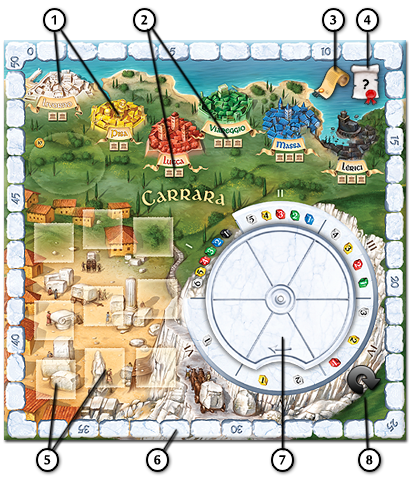
- During the game click on one of the cities to score it;
- Number of buildings required to score each single city;
- Game history icon (online game): click on this icon to display the game history and the final score (at the end of the game);
- Objectives board icon (online game): click on this icon to display the objectives board with the cards;
- Spaces for the building tiles;
- Scoring track;
- On the wheel during the game there will be the blocks to purchase; each section has different prices for the blocks (see the number within the coloured blocks next to each section);
- Wheel turn icon (online game): click here to spin the wheel and draw new blocks.
Components and game setup
- First, set the game board and the objectives board in the middle of the table. In the online game click on the white icon with a "?" on the main board (top right corner) to see the objectives board;
- Each player takes a player board and a screen in their color (in the online game there is no screen, cause all the information are available to other players). Regarding the player board, use the side with trees in the lower right-hand corner;
- Each player takes coins worth a total value of 20 and places them behind their screen. The remaining coins are left next to the board as the bank;
- The last player to have visited or seen a picture of Italy is the start player (in the online game the start player is randomly determined). The start player takes the Start Player token and a black block. The second player, in clockwise order, takes a blue block, the third player a green block, and the fourth and last player a red block. Every player should now have a block of a different color, which they put behind their screen (there are 42 blocks in total, 7 in each of the 6 colors);
- The wheel is divided into 6 sections (I-VI). Align the section of the wheel with the arrow with Section V. Take 1 block of each color and put them on Section I of the wheel (put the remaining blocks in the bag);
- Shuffle the 30 Building tiles face-down. Take 9 buildings and place them face-up on the spaces in the lower left-hand corner of the board. The remaining buildings form a draw pile that is placed next to the board. There are 6 types of buildings divided into 2 categories: the City buildings (the 20 buildings with an orange background) and the Land buildings (the 10 buildings with a green background);
- The 36 objects are sorted by type. Take 1 object of each type and place them on the spot reserved for them on the board (total of 6 objects). The remaining 5 objects of each type are placed next to the game board;
- Each player takes the 7 scoring markers of their color and places them in front of themselves. Then, each player takes 1 marker and places it on the space 0 of the scoring track. Each player should now have 6 markers in front of them;
- The points markers (4x 50/100) are placed next to the board (these markers are not necessary in the online game).
Note that in the online game, in the player information area located in the top right corner, the start player is marked with a white bar under the player flag and the player on turn is marked with a black arrow near the same flag.
Playing the game
Starting with the start player and going clockwise around the table, each player takes one action during his turn. He may choose among the following actions:
- Buy blocks;
- Build buildings;
- Score.
After the current player's action, the next player to his left takes her turn, and so on.
Note that in the online game you can choose the action directly clicking in the appropriate area; spin the wheel by clicking on the wheel arrow and select blocks (Buy blocks action); select an available building tile on the main board (Build buildings action); select a building type/category on the player board or select a city on the main board (Score action).
Action I: Buy blocks






This action allows a player to buy blocks from the wheel. These blocks will be used later when building.
- When you choose the "Buy blocks" action, you must first rotate the wheel clockwise by one section;
- After that, you must draw blocks out of the bag, without looking, until there is a total of 11 blocks on the wheel (this action is automatic in the online game). These new blocks are put onto section I;
- You can now buy the block(s) of your choice from one section. Each section shows the cost for each color of blocks. If a color is not shown, you can take the blocks of that color for free.
Special case: If, after choosing the "Buy blocks" action and rotating the wheel a player cannot buy any blocks (because he does not have enough coins or because there are no free blocks), the following occurs: that player must raise his screen to show that he does not have enough coins to buy a block. Then, he takes 2 coins from the bank. This ends his turn; he is not allowed to buy any blocks after taking the coins from the bank. In the online game the 2 coins are assigned automatically if after rotating the wheel, there isn't a possible purchase.
Special case: When the bag is empty, no blocks are added to the wheel. A player can still choose the "Buy blocks" action. The player will turn the wheel one section clockwise and will then be able to buy the blocks that are already there.
Special case: If the wheel is empty and there are no blocks in the bag, the player must choose another action.
Action II: Build buildings
With this action, a player can use blocks to build one of the available buildings present on the board. Once built, the player put the chosen building on her player board. Players pay for the buildings they build by returning blocks into the bag. Before seeing the building action in detail, the following section will describe the building types as well as the player board in detail. This information is very important to understand the building rules properly.
The building types
Each Building tile shows the building type, an object, and the number of blocks required to build this building (i.e. the cost). There are 6 different types of buildings. Each of them is present 5 times, with a cost ranging from 1 through 5. Each type of building is also associated with a specific object (Palazzo = Crown, Biblioteca = Book, and so on). Furthermore, each building belongs to a specific category: City buildings have a orange background (and a orange border in the online game) and Land buildings have a green background (and a green border in the online game).
Building tiles in the original game
Building tiles in the online game
 Building type: Palazzo / Category: City Building type: Palazzo / Category: City
|
 |
 |
 |
 |
 |
|
 Building type: Biblioteca / Category: City Building type: Biblioteca / Category: City
|
 |
 |
 |
 |
 |
|
 Building type: Porta / Category: City Building type: Porta / Category: City
|
 |
 |
 |
 |
 |
 Building type: Cattedrale / Category: City Building type: Cattedrale / Category: City
|
 |
 |
 |
 |
 |
|
 Building type: Villa / Category: Land Building type: Villa / Category: Land
|
 |
 |
 |
 |
 |
|
 Building type: Castello / Category: Land Building type: Castello / Category: Land
|
 |
 |
 |
 |
 |
The player board
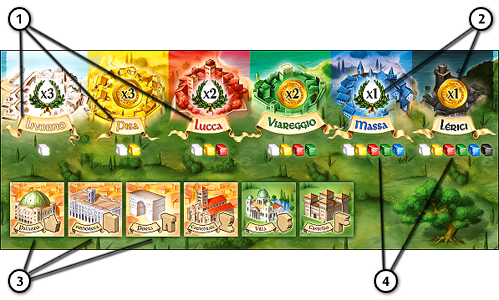
- Cities where to build: Livorno, Pisa, Lucca, Viareggio, Massa and Lerici;
- Value of the city in victory points or coins;
- During the game click on one of these areas to score a specific building type;
- Blocks accepted to build in each single city (e.g. you can only use white blocks to build in Livorno).
How is the "Build buildings" action resolved?
- Take 1 of the 9 available buildings present on the board (not from the pile);
- Build that building in one of your cities;
- Pay the cost with blocks. Return into the bag a number of blocks equal to the number shown on the building;
- Refill the space with a new building from the pile, placed face-up (this action is made automatically in the online game, after a player finishes his turn). If the pile is empty, no new building are added. Once a player has finished building, his turn is over.
In which cities a player can build?
The city where a player may place their building depends on the color of the blocks used to pay for the building. Player can use blocks of different colors, although they do not have to. A player can build in...
- Livorno with white blocks only;
- Pisa with white and yellow blocks only;
- Lucca with white, yellow and red blocks only;
- Viareggio with white, yellow, red and green blocks only;
- Massa with white, yellow, red, green and blue blocks only;
- Lerici with any blocks.
Action III: Score






This action allows the player to receive money  , victory points
, victory points  and objects
and objects 




 . Each player has 6 scoring markers. Consequently, a player can only do this action 6 times during game.
. Each player has 6 scoring markers. Consequently, a player can only do this action 6 times during game.
What can a player score?
- A player can score buildings (by type);
- A player can score a city.
The player scores a type of building
- Choose the building type that you wish to score. You must have at least 1 building of that type, and cannot already have scored it. Then, you score all the buildings of that type. You immediately receive coins and/or victory points, depending on the cities where your buildings of this type were built.
- Determine how many coins or victory points you receive: to do so, multiply the cost of each building of this type by the value of the city in which it was built. For each scored building, take 1 object of the appropriate type. If there are no more objects of that type in the supply, you receive nothing (or only those that were still available). However, a player always receives victory points or coins!
- The victory points are immediately added by moving your player's marker on the scoring track. The coins and objects are placed behind your screen. Each player can score each type of building once per game. A player may never do a Scoring action using another player's player board.
Note that when scoring in the online game, the victory points/coins/objects determination is done automatically.
The player scores a city
City scoring is done with the City section of the main game board (the City Section is only used for scoring, it is not possible to build there).
- You choose the city that you want to score. However, two conditions must first be fulfilled: Firstly, the city must not have been scored yet (by any player). In other words, a marker cannot be on that city on the board. Secondly, you must have built at least 2 buildings (in Livorno, Pisa or Lucca) or 3 buildings (in Viareggio, Massa or Lerici) above the scored city on your player board. If the two conditions are met, you receive points or coins, depending on the city being scored.
- To determine how many coins or victory points you receive, you first add up the cost of all your buildings in the city you are scoring, and you then multiply this sum by the value of the city. You also take exactly 1 object (of the corresponding type) for each building in the scored city. If there are no more objects of the required type in the supply, you receive nothing (or only those that were still available). A player always receive victory points or coins! You then place one of your markers on the game board, on the city you have just scored.
- The victory points are immediately added by moving your marker on the scoring track. The coins and objects are put behind your screen. Each city can only be scored once per game. Once a player has finished scoring, his turn is over.
Additional purchase
After every action (I: Buy blocks, II: Build buildings, III: Score), you can make an additional purchase. You can buy exactly one object from those located on the board. To do so, simply take one of the available objects, put it behind your screen, and pay 10 coins to the bank. If there are no objects on the board, then no objects may be purchased. The objects on the board are never refilled.
Game end
The game can end in one of two ways:
1. The last building on the board is built.
The game ends when the last building (i.e. the 30th building) is removed from the board and built by a player. The round is completed to allow every player to have the same number of rounds. After this last round, players proceed with the final scoring.
OR
2. A player completed the 3 objectives from the Objectives board and announced the end of the game.
The three objectives
Three objectives are printed on the Objectives board. These affect the end of the game and the victory points that players receive during the final scoring. In the online game you can click on the white icon with a ? (on the top right corner of the main board) to display the Objectives board. Very important: The information on every objective always represents a minimum requirement!
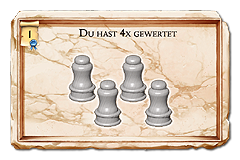 Objective I (Top Card, brown):
Objective I (Top Card, brown):
You must have done at least 4 Scoring actions. This is only a game end objective. Players receive no victory points at the end of the game for this objective.
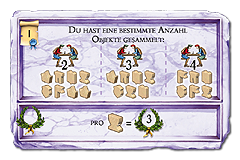 Objective II (Object Card, purple):
Objective II (Object Card, purple):
You must have collected a certain number of objects:
- 8 objects with 2 players;
- 7 objects with 3 players;
- 6 objects with 4 players.
During the final scoring each player receives 3 victory points per collected object.
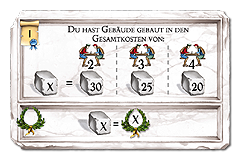 Objective III (Building Card, gray):
Objective III (Building Card, gray):
You must own buildings with a total cost of:
- 30 building blocks with 2 players;
- 25 building blocks with 3 players;
- 20 building blocks with 4 players.
During the final scoring each player receives a number of victory points equal to the sum of his buildings cost.
The Bonus Points Cards (green) are not used in the basic version of the game!
Announcing the end of the game
- As usual, the player takes one of the 3 actions. After he has completed all 3 objectives, he may announce the end of the game. He raises his screen to show that he has collected the required number of objects (this is not needed in the online game). Players can clearly see the other two objectives (scored 4 times and the total building costs). A player may already have completed the 3 objectives at the beginning of his turn. He may have decided not to announce the end of the game previously. Regardless, a player may also announce the end of the game at the beginning of his turn;
- The player immediately receives 5 victory points for announcing the end of the game;
- Then, the current round is played until the end, so that each player has the same number of turns;
- The game is now over and players proceed with the final scoring.
Note: Players who have yet to play during this final round do not have to take one last action. Another player may not announce the end of the game, even if he has completed all 3 objectives.
Note for the online game: The game end is declared by clicking on the flag displayed in the top center of the player board (the flag with checkers). If the three objectives are not still fulfilled, the flag is surrounded by a gray border and it is not possible to declare the end of the game.
Important: Each player scores points in the final scoring, regardless of the number of objectives they have completed.
Final scoring
At the end of the game, all players receive points. Each player receive points for:
- 3 victory points per collected object (as per the purple Object Card);
- The sum of his buildings' cost in victory points (as per the gray Building Card;
- Each 5 coins = 1 victory point
In the online game the final scoring table is displayed automatically at the end of the game, within the "Game history" window.
Tiebreaker
How are ties resolved? If two or more players have the most points at the end of the game, then the player with the most blocks in his personal supply wins the game. The color of the blocks does not matter. If there is still a tie, then there is more than one winner.
Tactical hints
- Do not play your first game with the expansion components! (Well, this is not a problem, cause the expansion is still not available online...);
- You will rarely build buildings in every city;
- During a game, each player has the possibility to score 6 times. In order to announce the end of the game, a player needs only have scored 4 times. As such, a player does not have to use all 6 of his scoring markers;
- Watch your opponents carefully! Scoring cities on the game board is often key to victory!
- Watch your opponents carefully! Is someone about to announce the end of the game?